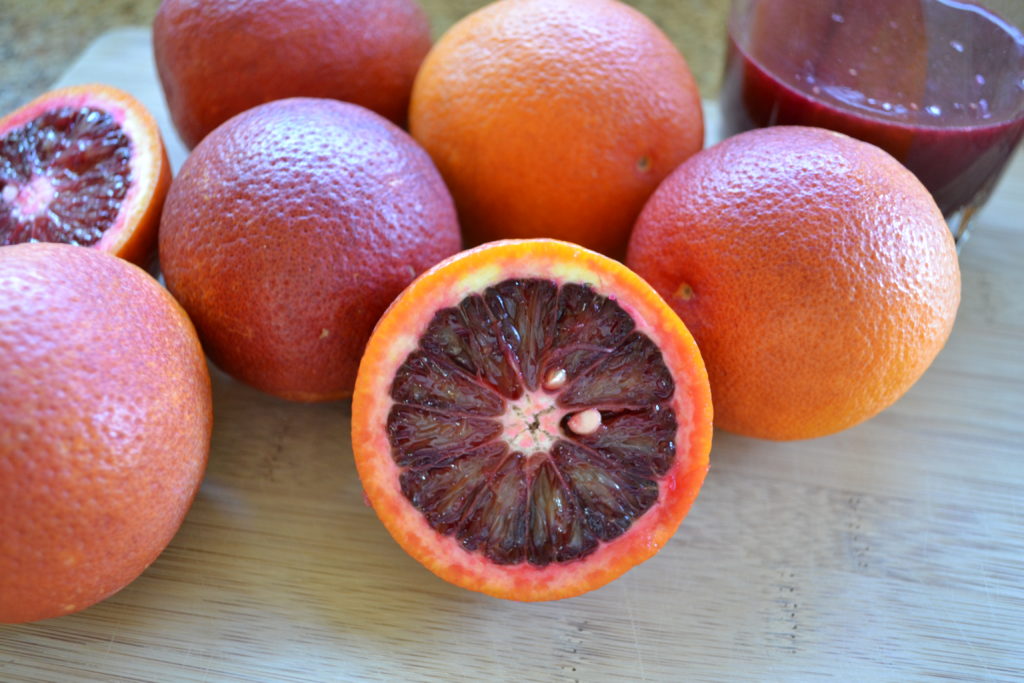Spring is around the corner and citrus season is in full swing here in northern California! Our lemons are out in full force along with the many other varieties of citrus grown by neighbors throughout our neighborhood. Last night Rick brought home some blood oranges, which if you have not had the opportunity to experience yet, have a red to orange outer rind and pink to red flesh on the inside.

Their flavor is much different than your standard Valencia or navel orange. Blood oranges to me taste like a cross between pink grapefruit and raspberries – both of which I love! Even though I enjoy eating sweet-tasting fruits, I have a special place in my heart for savory/astringent/tart/bitter flavors, so as of last night, these blood oranges have become one of my favorite fruits next to pomegranates. Speaking of which, the juice I made with these blood oranges had a very similar deep red color to my homemade pomegranate juice.
That deep red coloring of blood oranges gives us a clue as to what important nutrient we can find in them. Generally, when fruit has a blue, purple, or deep red coloring, the antioxidant anthocyanin is present. This is the case with blood oranges along with blueberries, blackberries, raspberries, and other fruits of similar color.
Not surprisingly, blood oranges have important nutrients that one finds in other citrus fruits like vitamin C and calcium. What is surprising is the similarity in carbohydrate content between blood oranges and their more popular counterpart, navel oranges.
Here’s a comparison of carbohydrates and other nutrients per 100 g of blood and navel oranges:
| Blood oranges | Navel oranges | |
| Calories | 50 | 49 |
| Total carbohydrate | 11.4 g | 12.5 g |
| Sugars (non-specified) | 8.6 g | 8.5 g |
| Vitamin C | 51 mg | 59 mg |
| Calcium | 43 mg | 43 mg |
So, even though blood oranges have a flavor that is more on the tart than sweet side, the carbohydrate content is similar to the sweeter navel orange. I would be interested to see how the simple carbohydrate content of each compares, such as the amount of fructose, glucose, and sucrose in each variety and look forward to a time when this information is available.
On another note, I found a recent interesting study done on the effect of orange juice consumption on gut microbiota. This study was not done using blood oranges, but with more common sweeter varieties. It was a small study with 10 women, who consumed orange juice for 2 months. The researchers found after those two months that consumption of the orange juice was associated with an increase in the population of Bifidobacterium species and Lactobacillus species, both probiotics, in their respective microbiomes, along with a reduction in ammonia production by gut flora and an increase in gut flora production of short chain fatty acids. All of these changes are positive indicators of microbiome health improvement. The study also found positive changes in blood biochemical parameters including increased insulin sensitivity!
You can read more about this study by searching for the study information shown below. It’s important to note that this study was done using pasteurized orange juice, so naturally I would love to see what the results would look like using fresh squeezed unpasteurized orange juice! Nonetheless, I thought you might find this information to be interesting as I did. I’ve seen many studies that show improvement in microbiome health with the addition of fruits and vegetables, so the outcome of this study is not surprising. It’s just another testament to the many health benefits of whole natural plant foods!
Lima ACD, Cecatti C, Fidélix MP, Adorno MAT, Sakamoto IK, Cesar TB, Sivieri K. Effect of Daily Consumption of Orange Juice on the Levels of Blood Glucose, Lipids, and Gut Microbiota Metabolites: Controlled Clinical Trials. J Med Food. 2019 Feb;22(2):202-210.
Nutrition information on navel and blood oranges: nutritiondata.self.com
